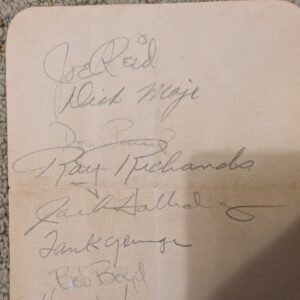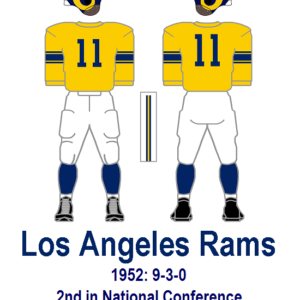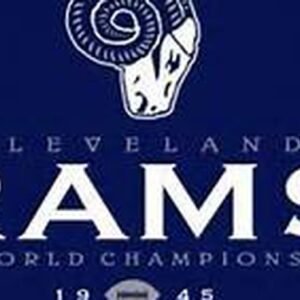The 1997 St. Louis Rams season marked another challenging chapter in the team’s history as they continued to rebuild and find their identity in St. Louis, following their relocation from Los Angeles in 1995. The team finished the season with a 5-11 record, a slight improvement from the previous year’s 6-10 finish, but still far from contention in the NFC West.













Under Rich Brooks, the Rams’ head coach, the franchise continued to experience growing pains in both offensive and defensive categories. The 1997 season highlighted the Rams’ struggles at the quarterback position and defensive inconsistencies, while also showcasing a few bright spots that would help the team build toward a more successful future.
Record: 5-11
The Rams finished the 1997 season with a 5-11 record, continuing to reside at the bottom of the NFC West standings. Despite a few close games, they could not put together consistent performances throughout the season. The team showed flashes of potential but often fell short, losing several close games. Their offensive struggles and an inability to stop opposing teams on defense were major contributors to the team’s subpar season.
Quarterback Play
The quarterback position continued to be a major issue for the Rams in 1997. Chris Miller was the starting quarterback for most of the season but struggled with consistency. He finished the year with 2,470 passing yards, 10 touchdowns, and 15 interceptions, highlighting his struggles to protect the ball and consistently lead the offense. While Miller had flashes of solid play, his inability to be the steady presence the Rams needed at quarterback was apparent.
The Rams also began to give Tony Banks more playing time in his second year. While Banks showed some promise as the team’s future quarterback, he was still very raw and inexperienced. He had his ups and downs in 1997, but the coaching staff clearly believed in his potential. Banks showed flashes of his skill set but still had much to learn before becoming a reliable starter. The quarterback carousel continued to hold back the Rams’ offense, as stability at the position was nowhere to be found.
Offensive Struggles
The offensive unit as a whole continued to struggle in 1997. The Rams could not establish a consistent rhythm in their attack and frequently found themselves playing from behind. Troy Davis, the team’s leading rusher, showed some ability, finishing with 976 rushing yards and 4 touchdowns. However, the Rams’ offensive line was inconsistent, and Davis couldn’t carry the team alone, especially with the lack of a solid passing game to complement his efforts.
Wide receiver Isaac Bruce continued to be the team’s best offensive weapon. He caught 70 passes for 1,096 yards and 6 touchdowns, and despite the team’s struggles, Bruce consistently proved to be one of the most talented receivers in the NFL. He was a rare bright spot for an offense that lacked depth and consistency, with other pass-catching options not stepping up to take the pressure off Bruce.
The Rams’ offense remained very one-dimensional. The team failed to develop a balanced attack, as the passing game was inconsistent, and the running game did not have enough firepower to take control of games. The Rams’ offense still needed significant work to be competitive in the NFC West.
Defensive Struggles
Defensively, the Rams had trouble stopping opposing teams. The defensive line had talent, but the pass rush was inconsistent. Sean Gilbert, the Rams’ defensive tackle, was one of the team’s best players, and Kevin Greene, the linebacker, continued to be a dominant force. Greene was the anchor of the defense, finishing the year with 8 sacks and continuing to be one of the league’s most feared linebackers.
However, the Rams’ defense struggled to make game-changing plays. They allowed too many big plays in the passing game, and they had issues with tackling and coverage. The secondary, including players like Todd Lyght and Aeneas Williams, was often exposed by opposing offenses. While the Rams had some strong individual performers, the defense as a whole was inconsistent, and the unit was not able to help the team stay competitive in games.
Special Teams
The Rams’ special teams unit was not a major liability, but it also did not provide the team with any game-changing plays. Jeff Wilkins, the kicker, was reliable once again, converting on 21 of 27 field goals and adding a consistent scoring option. However, the return game failed to make a significant impact on the field position battle.
Bright Spots and Future Outlook
While the 1997 season was another disappointing one for the Rams, there were a few positives that showed promise for the future. Isaac Bruce continued to establish himself as one of the league’s best wide receivers, and the development of Tony Banks at quarterback provided hope for the future at that position. Troy Davis emerged as a reliable running back, and Kevin Greene continued to be the heart of the defense.
The Rams were still in the early stages of rebuilding, and while they had some solid young players, the team had several key areas that needed to be addressed moving forward, particularly at quarterback and on defense. The Rams had some talent but lacked the consistency required to compete with other teams in the NFC West. The team would need to make improvements in both the draft and free agency to get closer to playoff contention.
With a new stadium (the Trans World Dome) and a loyal fan base in St. Louis, the Rams had the foundation to eventually turn things around. However, the 1997 season was another year of growing pains, and it would take more time for the franchise to become a legitimate contender.
Key Players:
- Isaac Bruce (WR): Bruce was once again the Rams’ top offensive weapon, continuing to establish himself as one of the NFL’s premier wide receivers.
- Kevin Greene (OLB): Greene remained the anchor of the Rams’ defense, providing leadership, and generating pressure on opposing quarterbacks.
- Troy Davis (RB): Davis rushed for nearly 1,000 yards, solidifying his place as the Rams’ top running back.
- Chris Miller (QB): Miller continued to struggle at quarterback, leading the team to consider moving forward with younger options like Tony Banks.
- Tony Banks (QB): Banks showed promise as the team’s future quarterback, though he still had a lot of development ahead of him.
Looking Ahead:
The 1997 season was another step in the rebuilding process for the St. Louis Rams, who were still struggling to establish themselves as a competitive team in the NFC West. The team had a number of key players who could form the core of future success, but they needed to continue building through the draft and free agency. With time, development, and some key roster moves, the Rams would eventually turn the corner and return to playoff contention in the years to come. The 1997 season was another frustrating chapter in the Rams’ rebuild, but it also laid the groundwork for better days ahead.
Head Coach: Dick Vermeil
- To be listed, a player must have played at least one game for the team during this season.
- * Hall of Fame
- + Primary starter
| Pos | # | Player | GP | GS | Start Pos | Exp | DOB | Ht | Wt | College | |
|---|---|---|---|---|---|---|---|---|---|---|---|
| CB | Taje Allen | 14 | R | 11/06/1973 | ‘ “ | Texas | |||||
| QB | Tony Banks | 16 | 2 | 04/05/1973 | ‘ “ | Michigan State | |||||
| P | Will Brice | 6 | 1 | 10/24/1974 | ‘ “ | Virginia | |||||
| C | Bern Brostek | 1 | 8 | 09/11/1966 | ‘ “ | Washington | |||||
| WR | Isaac Bruce | 12 | 4 | 11/10/1972 | ‘ “ | Memphis State | |||||
| DE/DT | Kevin Carter | 16 | 3 | 09/21/1973 | ‘ “ | Florida | |||||
| LB | Charlie Clemons | 5 | 1 | 07/04/1972 | ‘ “ | Georgia | |||||
| TE | Ernie Conwell | 16 | 2 | 08/17/1972 | ‘ “ | Washington | |||||
| WR | Keith Crawford | 15 | 4 | 11/21/1970 | ‘ “ | Howard Payne (TX) | |||||
| LB | Nate Dingle | 9 | 3 | 07/23/1971 | ‘ “ | Cincinnati | |||||
| LB | Troy Dumas | 2 | 2 | 09/30/1972 | ‘ “ | Nebraska | |||||
| G | Ernest Dye | 13 | 5 | 07/15/1971 | ‘ “ | South Carolina | |||||
| DT | D’Marco Farr | 16 | 4 | 06/09/1971 | ‘ “ | Washington | |||||
| WR | Malcolm Floyd (Seaborn) | 4 | 4 | 12/29/1972 | ‘ “ | Fresno State | |||||
| T | Wayne Gandy | 16 | 4 | 02/10/1971 | ‘ “ | Auburn | |||||
| G/TE | John Gerak | 16 | 5 | 01/06/1970 | ‘ “ | Penn State | |||||
| C | Mike Gruttadauria | 14 | 2 | 12/06/1972 | ‘ “ | Central Florida | |||||
| LB | Britt Hager | 13 | 9 | 02/20/1966 | ‘ “ | Texas | |||||
| FB | Craig Heyward | 16 | 10 | 09/26/1966 | ‘ “ | Pittsburgh | |||||
| P | Mike Horan | 10 | 14 | 02/01/1959 | ‘ “ | Long Beach State | |||||
| TE | Mitch Jacoby | 14 | 1 | 12/08/1973 | ‘ “ | Northern Illinois | |||||
| S | Billy Jenkins | 16 | 1 | 07/08/1974 | ‘ “ | Howard | |||||
| DE/DT | Bill Johnson | 16 | 6 | 12/09/1968 | ‘ “ | Michigan State | |||||
| LB | Mike A. Jones | 16 | 7 | 04/15/1969 | ‘ “ | Missouri | |||||
| LB | Robert Jones | 16 | 6 | 09/27/1969 | ‘ “ | East Carolina | |||||
| LB | Muadianvita Kazadi | 12 | R | 12/20/1973 | ‘ “ | Tulsa | |||||
| WR | Eddie Kennison | 14 | 2 | 01/20/1973 | ‘ “ | Louisiana State | |||||
| TE | Aaron Laing | 15 | 3 | 07/19/1971 | ‘ “ | New Mexico State | |||||
| RB | Amp Lee | 16 | 6 | 10/01/1971 | ‘ “ | Florida State | |||||
| CB | Todd Lyght | 16 | 7 | 02/09/1969 | ‘ “ | Notre Dame | |||||
| S | Keith Lyle | 16 | 4 | 04/17/1972 | ‘ “ | Virginia | |||||
| S | Gerald McBurrows | 8 | 3 | 10/07/1973 | ‘ “ | Kansas | |||||
| CB | Dexter McCleon | 16 | R | 10/09/1973 | ‘ “ | Clemson | |||||
| S/CB | Ryan McNeil | 16 | 5 | 10/04/1970 | ‘ “ | Miami (FL) | |||||
| T | Fred Miller | 15 | 2 | 02/06/1973 | ‘ “ | Baylor | |||||
| RB | Jerald Moore | 9 | 2 | 11/20/1974 | ‘ “ | Oklahoma | |||||
| RB | Ron Moore | 7 | 5 | 01/26/1970 | ‘ “ | Pittsburg State (KS) | |||||
| DE | Leslie O’Neal | 15 | 11 | 05/07/1964 | ‘ “ | Oklahoma State | |||||
| T | * | Orlando Pace | 13 | R | 11/04/1975 | ‘ “ | Ohio State | ||||
| LB | Roman Phifer | 16 | 7 | 03/05/1968 | ‘ “ | UCLA | |||||
| RB | Lawrence Phillips | 10 | 2 | 05/12/1975 | ‘ “ | Nebraska | |||||
| DT/NT/DE | Bryan Robinson | 11 | 1 | 06/22/1974 | ‘ “ | Fresno State | |||||
| TE/LS/DE | Jeff Robinson | 16 | 5 | 02/20/1970 | ‘ “ | Idaho | |||||
| WR | Jermaine Ross | 4 | 3 | 04/27/1971 | ‘ “ | Purdue | |||||
| CB | Joe Rowe | 2 | 1 | 12/08/1973 | ‘ “ | Virginia | |||||
| QB | Mark Rypien | 5 | 10 | 10/02/1962 | ‘ “ | Washington State | |||||
| CB | Mike Scurlock | 5 | 3 | 02/26/1972 | ‘ “ | Arizona | |||||
| WR | Torrance Small | 13 | 6 | 09/04/1970 | ‘ “ | Alcorn State | |||||
| G | Vernice Smith | 10 | 7 | 10/24/1965 | ‘ “ | Florida A&M | |||||
| LB | Lorenzo Styles | 3 | 3 | 01/31/1974 | ‘ “ | Ohio State | |||||
| WR | J. T. Thomas | 5 | 3 | 07/11/1971 | ‘ “ | Arizona State | |||||
| RB | David Thompson | 11 | 1 | 01/13/1975 | ‘ “ | Oklahoma State | |||||
| T/C/G | Ryan Tucker | 7 | R | 06/12/1975 | ‘ “ | Texas Christian | |||||
| CB | Marquis Walker | 11 | 2 | 07/06/1972 | ‘ “ | Southeast Missouri State | |||||
| LB | Brett Wallerstedt | 2 | 4 | 11/24/1970 | ‘ “ | Arizona State | |||||
| T | Zach Wiegert | 15 | 3 | 08/16/1972 | ‘ “ | Nebraska | |||||
| K | Jeff Wilkins | 16 | 4 | 04/19/1972 | ‘ “ | Youngstown State | |||||
| DT/DE | Jay Williams | 16 | 3 | 10/13/1971 | ‘ “ | Wake Forest | |||||
| S | Toby Wright | 11 | 4 | 11/19/1970 | ‘ “ | Nebraska | |||||
| DT | Jeff Zgonina | 15 | 5 | 05/24/1970 | ‘ “ | Purdue |



